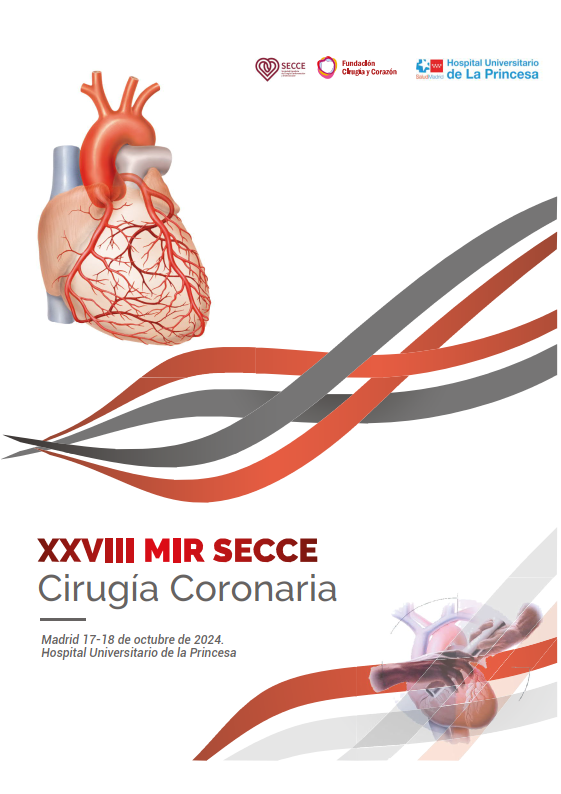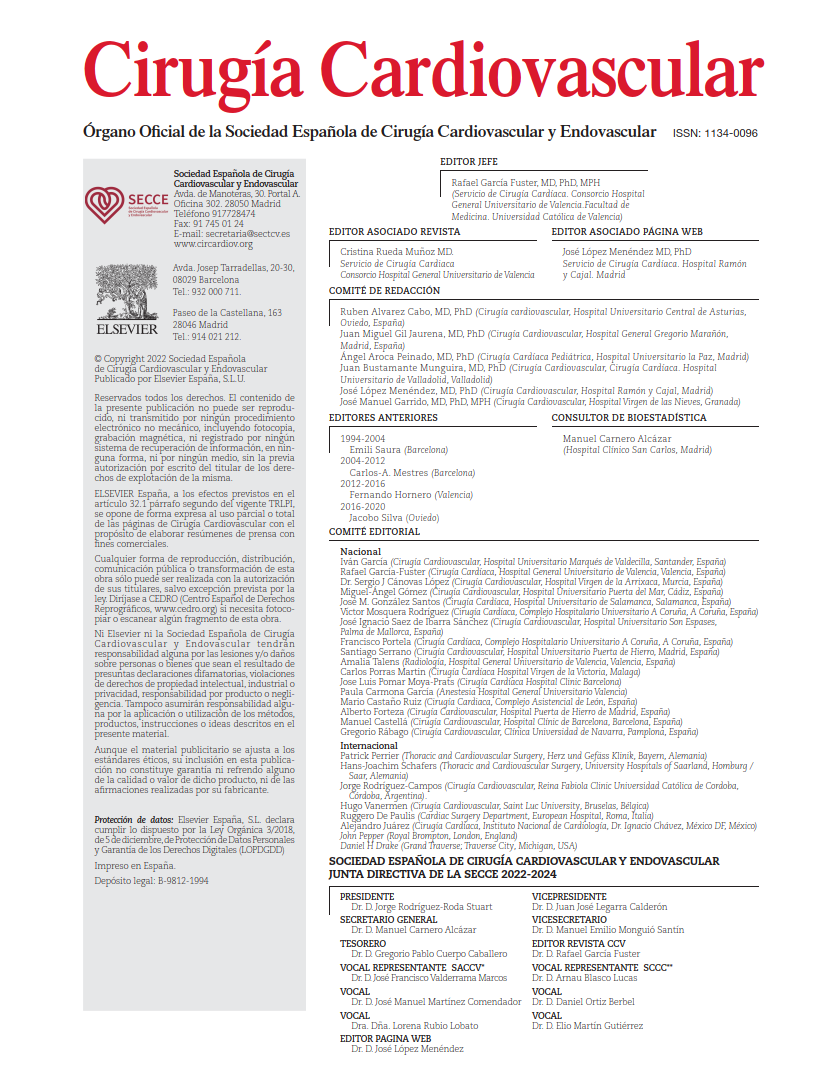Aortic stenosis is the most common valvular heart disease in Europe. Its management has evolved notably over the past decade due not only to the expansion of transcatheter therapies, but also to a better understanding of its natural history. The 2021 joint guidelines from the ESC and EACTS introduced substantial updates to the recommendations for intervention, particularly concerning asymptomatic patients and the choice between surgery and transcatheter aortic valve implantation (TAVI). This article summarizes the current indications and offers a surgical interpretation grounded in contemporary evidence.
Summary of current recommendations
- Symptomatic patients with severe AS → always consider intervention (Class I):
- Presence of dyspnea, angina, or syncope.
- Echocardiographic confirmation: peak velocity ≥4.0 m/s, mean gradient ≥40 mmHg, or aortic valve area ≤1.0 cm².
- Asymptomatic patients with severe AS → intervention in selected cases:
| Clinical scenario | Recommendation |
| LVEF <55% * | Class I |
| Exercise testing with symptoms or hypotension * | Class IIa |
| Repeated measurements with peak velocity ≥5.5 m/s | Class IIa |
| Rapid progression (increase ≥0.3 m/s per year) * | Class IIb |
| Anticipated high surgical risk in the near future | Class IIb |
* Criteria supported by recent evidence published after the 2021 guidelines (e.g., AVATAR, RECOVERY).
- Choosing between SAVR and TAVI based on age, risk profile, and anatomy:
| Patient profile | Preferred approach |
| <75 years, low risk, favorable anatomy | Surgical aortic valve replacement (SAVR) |
| ≥75 years or high surgical risk | TAVI if anatomy is suitable |
| Complex scenarios or high comorbid burden | Individualized Heart Team decision |
COMMENTARY:
Severe symptomatic AS remains one of the few conditions in cardiology where intervention is clearly indicated and confers a substantial survival benefit. When symptoms such as dyspnea, angina, or syncope are present, timely valve replacement—either surgical or transcatheter—is warranted unless contraindicated.
In contrast, management of asymptomatic patients presents a greater challenge. The 2021 ESC/EACTS Guidelines expanded the indications for intervention in this group, including LVEF <55%, symptom induction or hypotension during exercise testing, persistent peak velocity ≥5.5 m/s, and rapid progression of stenosis. Recent studies published after the guideline release have reinforced—and in some instances expanded—these recommendations.
The RECOVERY trial (2019) was among the first to demonstrate that early surgical intervention in asymptomatic patients with preserved LVEF improves overall survival and reduces sudden cardiac death and hospitalization. The AVATAR trial (2021), which included a European population and a pragmatic design, confirmed these findings by showing that early surgery was associated with better outcomes compared to conservative management.
Concurrently, new evidence is emerging regarding patients who fall outside the conventional definition of severe AS. The TAVR-UNLOAD trial (2023) assessed the role of TAVI in patients with moderate AS and reduced LVEF. Despite not meeting traditional echocardiographic criteria for severe disease, this population experienced clear improvements in functional status and reduced hospitalizations with transcatheter therapy, underscoring the prognostic importance of ventricular dysfunction over isolated valve area.
The choice between SAVR and TAVI is also evolving. Data from the PARTNER 3 and Evolut Low Risk trials confirm that TAVI is safe and effective even in younger, low-risk populations. These results are gradually shifting the paradigm toward broader indications for TAVI in selected younger patients with favorable anatomy. While TAVI is not yet broadly recommended in patients under 65, there is growing support for a more flexible, anatomy-based approach in patients with long life expectancy. Nonetheless, concerns regarding valve durability, conduction disturbances, and the feasibility of concomitant procedures continue to favor SAVR in younger candidates.
Beyond severity grading, surgical decision-making must incorporate a holistic assessment: LVEF trends, subtle symptoms, pulmonary hypertension, onset of atrial fibrillation, or increased LV end-systolic dimension are critical parameters. Early intervention should aim to prevent irreversible myocardial damage. Imaging tools such as global longitudinal strain or late gadolinium enhancement in cardiac MRI may play an increasing role in identifying subclinical myocardial fibrosis and selecting optimal candidates.
Current guidelines provide a robust framework, but evolving evidence sharpens our ability to identify the ideal timing for intervention. Heart Team discussions remain central, integrating clinical, anatomical, and functional data. In AS, time is myocardium, and the ideal therapeutic window should not be missed.
Other clinical scenarios that may also warrant intervention
While classic indications account for the majority of cases, other clinical contexts should also prompt consideration of valve replacement. The table below summarizes these additional situations:
| Clinical scenario | Potential indication |
| Moderate AS in patients undergoing cardiac surgery (e.g., CABG, mitral valve) | Consider concomitant aortic valve intervention (Class IIa) |
| Moderate AS with reduced LVEF (<50%) and symptoms | Assess eligibility for aortic valve intervention (Class IIb) |
| Low-flow, low-gradient AS with reduced LVEF, confirmed severity with dobutamine | Intervention indicated if truly severe (Class I) |
| Significant pulmonary hypertension (>60 mmHg) | Consider intervention even if asymptomatic (Class IIb) |
| New-onset atrial fibrillation during follow-up | May indicate unrecognized decompensation (Class IIb) |
| Rapid progression (>0.3 m/s per year) with confirmed severe disease | Early intervention may be reasonable (Class IIb) |
These situations require individualized assessment and thorough discussion within the Heart Team, taking into account patient age, comorbidities, valve anatomy, and life expectancy.
What can we expect in future guidelines?
In light of the continuous accumulation of scientific evidence, it is likely that the next iteration of the ESC/EACTS Guidelines will introduce several key changes:
- Broader indications for asymptomatic patients, explicitly incorporating subclinical risk markers such as reduced global longitudinal strain or increased LV end-systolic dimension.
- Lower thresholds for intervention in moderate AS with impaired LVEF, supported by findings from TAVR-UNLOAD.
- More flexible age criteria for TAVI, given the favorable safety and efficacy profile observed in younger patients with suitable anatomy (e.g., PARTNER 3, Evolut Low Risk).
- Increased emphasis on functional capacity and quality of life metrics, beyond valve gradients or area alone, when selecting candidates for intervention.
Altogether, these trends suggest a shift away from the historical approach of deferring treatment until symptom onset. With improved diagnostic tools, better patient selection, and ongoing advances in technology, early, personalized, and safe intervention is likely to become the new standard.
REFERENCE:
Vahanian A, Beyersdorf F, Praz F, Milojevic M, Baldus S, Bauersachs J, et al.; ESC/EACTS Scientific Document Group. 2021 ESC/EACTS Guidelines for the management of valvular heart disease. Eur Heart J. 2022 Feb 12;43(7):561-632. doi: 10.1093/eurheartj/ehab395. Erratum in: Eur Heart J. 2022 Jun 1;43(21):2022. doi: 10.1093/eurheartj/ehac051.



